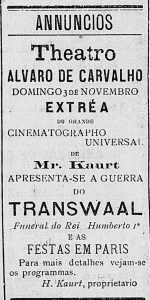The arts in general and theater in particular began to flourish in the second half of the XNUMXth century, when Florianópolis was still called Nossa Senhora do Desterro and when the only existing theater - Teatro São Pedro de Alcântara, already in ruins , no longer offered conditions for the presentation of local and foreign theater groups.

Laguna and São José were the first to have buildings dedicated to the art of acting and, in the opinion of the intellectual elite of the province, the capital of the province could not be left behind. Thus, in 1854, a group of people linked to the arts came together to found the "Sociedade Emprehendedora", charged with providing the means for the construction of the future Santa Isabel Theater, named in honor of Princess Isabel.
In 1857, the "Sociedade Emprehendedora" acquired the land, where the theater would be built, with the support of the government of the time. Years later, in 1871, with the work still unfinished, some dramatic and circus companies were already making use of the place, performing the first performances of the Theater. Finally, on September 7, 1875, 21 years after the creation of that society, the Santa Isabel Theater was officially opened. During the long-awaited opening ceremony, the National Anthem was played, with speeches and musical performances, and the poetry "A Liberdade", recited by the author himself, Horácio Nunes Pires. According to information at the time, more than a thousand people attended the opening of the Theater.
Initially, Teatro Santa Isabel was leased and managed by third parties, who were responsible for programming and maintenance of the building. In mid-1880, the provincial government decided to take over the administration of the house, setting a series of rules. One of them ordered that, for every ten shows presented at the venue, one should benefit the government, with the aim of improving the Capital. In 1890, the poet - and also playwright - Horácio Nunes Pires then became the theater supervisor.
ADVERTISING
In 1893, the Federalist Revolution broke out, which declared Santa Catarina independent from the rest of the country until the monarchy was restored, and the following year, in response to the Federal Government, the theater and other public buildings began to serve as accommodation for prisoners. In an attitude of breaking with the mornarchy, there was the Decree of 1894, which changed the name of the Santa Isabel theater to Álvaro de Carvalho, in honor of the first lieutenant of the Navy and the first playwright from Santa Catarina, author of the plays "Raimundo" and "Uma girl of judgment", among others. The author had died heroically during the Paraguayan War.

With Hercílio Luz, who took over the government in October 1894, the Álvaro de Carvalho Theater received attention again, with the first renovation measures and the acquisition of a chandelier to illuminate the entrance hall of the theater. At the turn of the century, the first major renovation of the concert hall was carried out, which, in 1955, had the interior space completely modified in a project by Tom Wildi Filho. Until 1982, when the Centro Integrado de Cultura was inaugurated, it remained the only large theater on the island of Santa Catarina, with 470 seats in the concert hall.
Two stained glass windows depicting popular scenes are seen in the access to the stairs and two canvases by the plastic artist Martinho de Haro decorate the foyer (waiting room) of the theater.
address and phone
Pereira Oliveira Square, 26 - Downtown.
(48) 3665-6400
See TAC programming.




